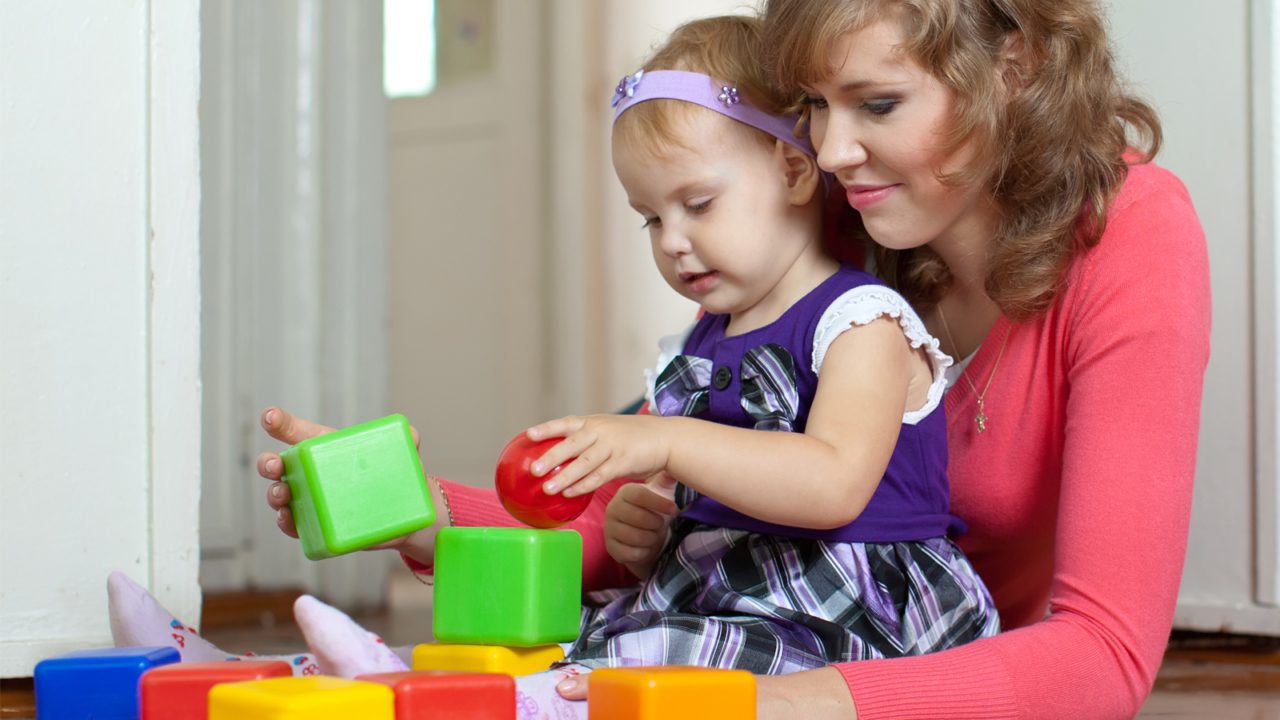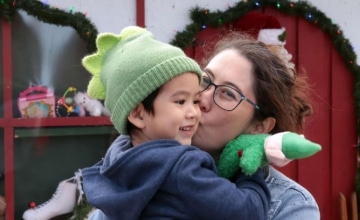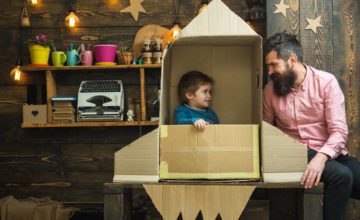As your 29-month-old becomes better able to control their body, you may notice that they are more excited than ever to show you what they can do. Browse the information and links below to learn more about 29-month-old milestones see what your little one is experiencing and learning this month.
IN THIS RESOURCE
- What It’s Like for You
- What It’s Like for Your Child
- What to Expect From Your Toddler’s Development
- Did You Know…
- Spotlight on: Learning to Use the Toilet
- Let’s Play: Activities That Nurture Bonding and Learning
- What’s on Your Mind?
- Expert Reviewers
What It’s Like for You
My daughter is quite a performer, says Justine, mother of Caroline, age 29 months. Her favorite words right now are ‘Watch dis!’ Then she will do one of her tricks—doing a dance or showing me how fast she can run or throw a ball. Then she goes, See DAT! and my job is to clap. This goes on all day!
As your toddler becomes better able to control her body, you may notice that she is more excited than ever to show you what she can do. It can be an incredibly fun tine for parents, as you see your child’s new skills in action. (Though, yes, you might have to sit through many performances of the same movement or routine over and over.) When your child sees your delight in her new skills—twirls, jumps, throws, and leaps—she feels smart and talented, which builds her self-confidence and self-esteem. This period of growing confidence and mastery over her body is a major milestone in your child’s third year. It also means that she is ready to work on new self-care skills like dressing, tooth-brushing, and face-washing—if these are skills you’d like her to learn.
What It’s Like for Your Child
I was building a block castle with my dad. We were almost done when I started to take it apart, block by block, and arrange the blocks in a straight line. My dad just picked up the blocks I had taken off and put them back on our castle. He didn’t get it! I didn’t want to build a castle anymore. I told Dad, No! He stopped and said, Well, I thought we were building a castle. So I told him: No. I makin’ a road. Daddy said, Ohhhh. Maybe I can make a bridge out of this shoebox top? I loved that idea. We put a car on top of the bridge and finished our road together.
What Your Toddler Is Learning: 29-Month-Old Milestones
Social-Emotional Skills:
- Cooperation as he plays with his dad, sharing materials and building a joint creation with blocks
- Managing frustration when he gets annoyed with Dad and then explains to him the change in building plans from castle to road
- Mutual respect and compromise as his father is flexible in adapting the plan
- Leadership skills and self-esteem as his Dad lets him take the lead in how and what they play, letting him know his ideas are important
Language and Thinking Skills:
- To use language to share his thoughts and plans, and to negotiate and compromise
- Problem-solving skills as he figures out how to lay the blocks in order to build the castle and the dragon path
- Creativity, imagination, and pretend play skills, as he creates a kingdom-and-dragon-filled world with his blocks, and as he accepts the shoebox top as a stand-in for a bridge
Physical Skills:
- Fine motor skills as he uses the small muscles in his hands and fingers to pick up and carefully place the blocks on his castle
What to Expect From Your Toddler’s Development
As you read the chart below, keep in mind that development is not a race and that every child grows at her own pace and in her own way. Your child may develop skills faster or slower than indicated below and still be on track. If you have questions or concerns, talk with your child’s health care provider or other trusted professional.
Your Toddler’s Development From 24 to 30 Months
| What Your Baby Can Do | What You Can Do to Connect With Your Baby |
|---|---|
I use my body to get me places! |
|
|
|
I am using language to tell you what I’m feeling and thinking. |
|
|
|
I am getting really good at playing pretend. |
|
|
|
I want to make friends but still need help with sharing. |
|
|
|
Did You Know…
That one-third of 29-month-olds are still not sleeping six consecutive hours at night? (This finding is from research was conducted through parent surveys of 1,741 Canadian toddlers.)
What the Research Means for You
While toddlers are growing up in many ways, some still struggle with the ability to soothe themselves at night-time. For every parent who thinks they are alone with their toddler’s sleep problems, there is another parent up at 3 a.m., too. The key is to understand why.
We all wake up at several points throughout the night and soothe ourselves back to sleep by adjusting our blankets and pillows, and our bodies, to the way we ease into slumber. To help your toddler learn this skill, the first step is to make sure that your child is falling asleep on her own. This means that after your child’s bedtime routine, you leave the room while she is still awake, but sleepy. (When you lay down with your toddler until she’s asleep, read her stories until she’s zonked out, or rub her back until she’s in dreamland, she learns to depend on these routines to fall asleep.)
If your toddler wakes at night and calls out or comes to get you, walk her back to her room and put her in her bed with minimal interaction. The more you interact, the more fulfilling the wake-up is to your child. Stick as close as possible to the same bedtime routine and respond in the same way each time your child wakes up. Children are comforted by knowing what to expect. So, for example, tuck her in, remind her that night-time is time for sleep, and leave the room. Keep repeating this routine until your child falls asleep. While the learning curve may involve a few restless nights and tears, with your guidance and consistency, your child will learn to sleep through the night.
Spotlight on: Learning to Use the Toilet
When and how to help your child learn to use the potty depends on how ready your child is. Your beliefs and values about toilet training also matter. There is not one “right” way.
Most children begin to develop control over their bowels and bladder by 18 months. This is necessary for children to physically be able to use the toilet. However there are other factors that contribute to when a child is ready to use the potty, such as a family’s cultural beliefs or a child’s temperament. For example, a child who has a harder time with change may need more time to make the transition to the potty.
Starting to train your child earlier does not mean he will learn to use the potty sooner. One study showed that children whose parents started training them before 27 months took longer to learn to use the potty compared to children whose parents started after 27 months.
Parents and children each have their own “job” to do when it comes to potty training.
Parents:
- Recognize and let your child know that he or she is in control of his or her body
- Ask your child whether he or she wants to use the potty or a diaper/pull-up each day
- Teach your child words for body parts, urine, and bowel movements
- Offer your child the tools—a small potty, potty seat, stool—necessary to succeed at toileting
- Label your child’s toileting habits. If your child is still in diapers, after he or she has had a bowel movement, you might say: You just pooped. * * Okay, let’s change you into a clean diaper so you are more comfortable.
- Handle potty accidents without anger
- Avoid punishment
- Show your child the logical benefits of using the potty—such as being able to choose his or her own underpants
Your child:
- Decides whether to use the toilet or wear a diaper/pull-up
- Learns his or her body’s signals for urine and bowel movements
- Uses the toilet at his or her own speed
Diapers, because they are now so absorbent, can be a disincentive to learning to use the potty as children don’t experience any of the natural discomfort of elimination. This cause-effect connection between urinating and feeling wet is important for children who are learning how and when to use the toilet. If the weather cooperates, it can be helpful to let your child run around outside without a diaper or in underpants to experience these sensations.
Finding a toilet training method that works for your family is the key. No matter how you do it, remember that potty training takes time, with many accidents along the way.
Children with special needs may take longer to learn to use the potty. They may also need special equipment and a lot of help and patience from you. For questions about toilet training, talk with your health care provider or community service coordinator.
Let’s Play: Activities That Nurture Bonding and Learning
Super-duper Supermarket
Line up empty cereal boxes, empty juice containers, and other food boxes. Give your child empty grocery bags, a basket, or box to use as her “grocery cart.” Let her shop for the food she’d like to buy. Use a cash register (i.e., a shoebox) to pretend to ring up her purchases. This game encourages your child to expand the play scenario by using her imagination and logical thinking skills. For example, perhaps she will tell you that she needs a pocketbook for her money or ask if you have any more boxes of cookies in your store.
Bottoms Up!
Stand at the end of a hallway, facing your child. If you call out “bottom,” your child sits on his bottom and scoots toward you. If you say “up,” your child stands up and runs toward you. If you say “freeze,” he has to stand still. As soon as he gets close enough to tag you, he switches places with you. Activities like this build muscle strength and coordination, promote listening and language skills, and teach social skills like taking cooperation and turn-taking.
What’s on Your Mind?
1. Lately, whenever we are making a transition (leaving the house for day care, leaving day care to go home, going upstairs to bed, etc.), my 2-year-old always wants to carry a bunch of things with him, usually whatever he was playing with at the moment. As a result, we might end up taking an armful of trains in the car to go to child care in the morning, or soccer balls home from day care at the end of the day. This weekend he even insisted on having his Elmo reading chair in bed with him before he would go to sleep. Why is he doing this—and should I indulge it?
My daughter was the ultimate toddler “bag lady” so I can picture your son and his soccer balls. Developmentally, what is happening for 2-year-olds is that they are beginning to understand that they are individuals who are separate and distinct from others. This is a social-emotional milestone called self-awareness—a sense of “Me.” What quickly follows, as you know, is “mine!” Not surprisingly, toddlers like holding onto some of their “own” things. It is also possible that your toddler may find some comfort in these items and use them as a way to cope with difficult transitions and separations. If he can’t have you in his bed, he needs something else that is special to him. Picture Linus and his blanket in the Peanuts comic strip.
So—what to do? One idea is to give your son a bag or child-size backpack that is his to fill and carry. Once it’s full, no more “treasures” can go in. The things that don’t fit he can choose to take with him the next day. Involve your child in deciding what to bring. For example, you can remind him that any toys he brings from home to child care will need to be shared with the other children. Making him part of the process empowers him to be a good decision maker and problem solver.
This approach of validating his need and supporting a coping skill, while also establishing some limits, is a good model for dealing with many behaviors you will encounter as your son grows.
2. My son is a picky eater. I’ve found that bribing him with dessert will get him to eat healthy foods first most of the time. Is this okay to do?
Children may be “picky” eaters for many reasons. Temperamentally, they may be more reluctant to try new things, or they may be extra-sensitive to tastes and textures. From a developmental standpoint, toddlers may become “picky” as a way to assert their independence. But bribing kids to eat—while tempting—is usually not a good idea in the long-term. Kids who learn how to make deals over carrots soon start to cut a deal about other things like brushing teeth or bedtime. Next thing you know they won’t do anything unless they get a reward.
Instead, try offering your child several healthy foods that you know he likes along with his dessert. Let him know this is his dinner and it is his choice about what and how much he eats. Research shows that when parents take this approach, and don’t make the sweet a reward but rather include it as part of dinner, children eventually eat healthier. Don’t worry if at first he only eats the cookie and one carrot. He won’t keep that up over the long-term simply because he’ll be hungry. And giving your son choices within limits eliminates parent-child power struggles over food. When your son says he is done, trust that he knows his own body—no deals. Keep in mind that research has found that children often have to be offered a new food as many as 10-15 times before they will try it. So keep the green beans comin’, someday soon your son may give them a try.
Expert Reviewers
- Terrie Rose, PhD, President and Founder, Baby’s Space
- Ross Thompson, PhD, Professor of Psychology, University of California at Davis
- Robert Weigand, MS, IMH-E, Director, Child Development Laboratory, Arizona State University





